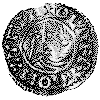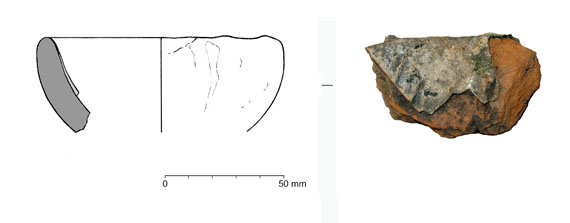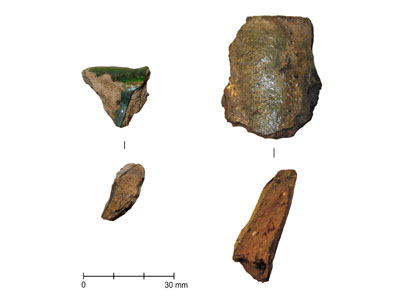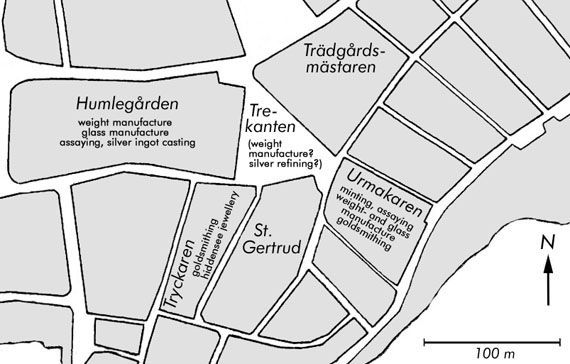The project described below, "11th century glass-working and silver processing in the Sigtuna mint", was finally reported in 2021, in the publication Hantverk i mynthusmiljö.
The aims of the project
In 2005 and 2006, the project "Metallurgic ceramics 800-1200 AD" examined finds from the large 1988-90 excavation of the Trädgårdsmästaren site in Sigtuna, Sweden. The investigation included an examination of 1200 kilos of slag and fired clay, from the perspective that crucibles and other ceramic process-containers belonging to metal crafts often pass unidentified during excavations and end up anonymously deposited among the mass finds of unidentified slag and clay. It turned out that this is indeed the case, and the project drastically updated the metalcraft finds from the excavation, thus specifing our knowledge of the activities between 985 and 1260 AD in the five excavated town plots.
A fragment of a glass crucible from the earlier glass-working phase (probably early 11th century) at the Humlegården site, with a reconstruction of its original shape. The glass on the fragments was a high lead-content glass with low content of alkali, a type of glass mainly used for trinkets like beads and rings.
At the excavation in the Humlegården town-block in 2006, remains of furnaces and crucibles from glass-working were discovered, dating from the first half of the 11th century and showing that, probably itinerant, glass artisans had returned several times to the site. Early medieval glass-working remains of this obvious type had not been found in Sweden before this excavation. The smithy where the earlier (990-1010 AD) finds were made also showed traces of the mass production of Viking period truncated iron weights. Since the latter activity also had been detected in the early 11th century mint of King Olof in the Urmakaren block nearby, excavated in 1990, it was assumed that this smithy may have had an intimate connection to the court, too. The chemical composition of the lead glass that was processed at the site resembled contemporary English lead glass, and the glass crucibles were similar to crucibles found in Glouchester and Lincoln. In the latter city, glass-working, silver refining and possibly minting had been concentrated to a certain area of the city, Flaxengate.
A few fragments of glass crucibles were indeed recorded (as domestic pottery) at the excavation of the Urmakaren mint, too, but it seems fair to assume that possible remains of glass furnace lining - if there were any at all - ended up unidentified together with the finds of fired clay just like lots of the metallurgic ceramics from the Trädgårdsmästaren site.
The project will re-examine all the fired clay from the Urmakaren excavation with fresh eyes in order to trace possible fragments of glass crucibles and furnace lining. In addition, an examination of the slag from the excavation will be made to secure the traces of silver processing - melting and refining - that could be expected in a mint, but are surprisingly sparse in the present find records. Hopefully, the examination can show if the production of means of payment, silver processing and glass-working going together, may be an expected 10th-11th century pattern.
Finally, yet another survey of the fired clay from the Trädgårdsmästaren site will be made, to secure and date possible traces of glass-working from this part of town. In this block there are no obvious finds of craft activities, apart from sparse domestic craftwork, from the early 11th century. Administered craft didn't start to flourish there until the period after the decline of the mint in the 1030's.
The project is supported by a research grant from the Berit Wallenberg Foundation
A map of the central parts of the city of Sigtuna, Sweden. The town blocks surrounding the St Gertrud block, the excpected site of the King's manor, and crafts performed in the late 10th and early 11th centuries.
Söderberg, A. & Gustafsson, Ny B. 2007. Från prestigevarugjutning till myntning. Tidigmedeltida metallurgi i kvarteret Trädgårdsmästaren, Sigtuna. Situne Dei. Sigtuna.
Bayley, J. 2008. Lincoln: Evidence for metalworking on Flaxengate and other sites in the city. English Heritage. Research Department Report Series 67-2008. Portsmouth.
Bayley, J. 2008. Lincoln: Evidence for glass-working on Flaxengate and other sites in the city. English Heritage. Research Department Report Series 68-2008. Portsmouth.
Malmer, B. 2010. Den Svenska Mynthistorien. Vikingatiden ca 995-1030. KMK & SNF. Stockholm.
Ros, J. 2009. Stad och gård. Sigtuna under sen vikingatid och tidig medeltid. Opia 45. Uppsala.
Söderberg, A. 2008. Metall- och glashantverk. På väg mot Paradiset - arkeologisk undersökning i kvarteret Humlegården 3 i Sigtuna 2006. Wikström, A. (ed). Meddelanden och rapporter från Sigtuna Museum nr 33. Sigtuna.
Söderberg, A. 2011. Eyvind Skáldaspillir's silver - refining and standards in pre-monetary economies in the light of finds from Sigtuna and Gotland. Situne Dei 2011. Edberg, R. Wikström, A. (eds). Sigtuna.
Wikström, A. Söderberg, A. Edberg, R. Pettersson, B. Roslund, M. 2011. Fem stadsgårdar - arkeologisk undersökning i kv. Trädgårdsmästaren 9 & 10 i Sigtuna 1988-90. Meddelanden och rapporter från Sigtuna Museum nr 52. Sigtuna.
Project report 2012. 11th century glass-working and silver processing in the Sigtuna mint - progress report, September 2012.
Project report 2014. 11th century glass-working and silver processing in the Sigtuna mint - updated progress report, September 2014.
Project report 2019. 11th century glass-working and silver processing in the Sigtuna mint - report 2019.
Söderberg, A. 2013. Om stratigrafi, tomtmönster och hantverk i kvarteret Urmakaren, Sigtuna. Situne Dei 2013. Claesson. E, Edberg, R. Källström. M. (eds). Sigtuna.
Gustavson, H. & Söderberg, A. 2014. Spår av skrivkunnighet och skrivvanor i det tidigmedeltida Sigtuna. Situne Dei 2014. Söderberg, A Claesson. E, Edberg, R. Källström. M. (eds). Sigtuna.
Söderberg, A. 2014. The brazing of iron and the metalsmith as a specialised potter. The Old Potter's Almanack, Vol 19, No 2 (2014) Spataro. M. (ed). Heidelberg.
Söderberg, A. 2015. The brazing package that King Olof's goldsmith forgot to open. Fornvännen - Journal of Swedish Antiquarian Research, 2015:1. Larsson, L. et al (eds). Stockholm.
O'Meadhra, U. & Söderberg, A. 2017. En säregen knivtyp i gränslandet mellan Jelling-, Mammen- och Ringerikestil. Situne Dei, Årsskrift för sigtunaforskning och historisk arkeologi. Söderberg. A. Hedenstierna-Jonson, C. Kjellström, A. Källström, M. Ljung, C. Runer, J. (eds). Sigtuna.
Söderberg, A. 2021. The Sigtuna scorifiers in context. Situne Dei, Årsskrift för sigtunaforskning och historisk arkeologi. Söderberg. A. Hedenstierna-Jonson, C. Kjellström, A. Källström, M. Ljung, C. Runer, J. (eds). Sigtuna.
Söderberg, A. 2021. Hantverk i mynthusmiljö. MORR 64. Sigtuna.
Web resource
Glass furnaces similar to the furnaces once used at the Humlegården site: |
Text & pictures by Anders Söderberg [infoATvikingbronze.com] - December 26 2011 - Updated June 12 2022 |



